BY ANTHONY AVILLO
In the fire service, there are two distinct environments in which you must control and perform (lead): the hard environment and the soft environment. Although to some they seem to be distinct and unrelated, their relationship and your understanding of how one affects the other, especially how the activities, successes, and failures in the soft environment influence the hard environment, are critical to your ongoing management of your personnel. You cannot possibly expect to succeed for long (if ever) in the hard environment if you fail in the soft environment.
As the fire service is not a business of black and white but one of varying shades of gray, so, too, are there various levels of softness and hardness in other areas such as the training environment and the “nothing-showing” or “investigation mode” environment. These are still technically soft environments, but as much as they are breeding grounds for future failures, they also represent great opportunities to fix your operation. Failure to do so can hurt you (and your subordinates) in ways you can never imagine. Your job is to be on the lookout for the warning signs of potential failures and begin to take the necessary steps to turn potential failures into actual successes.
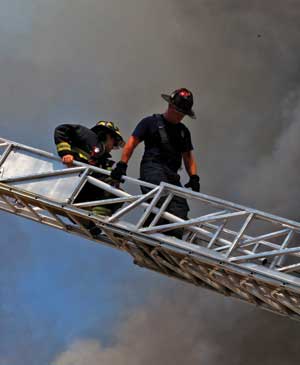 |
| (1) You just know that these firefighters were allowed to get away with lack of personal protective equipment in the soft environment (and probably were not taken to task here, either). Allowing a failure in the soft environment will sooner or later manifest itself with a failure in the hard environment. The officer is responsible to break the chain of unacceptable soft environment behavior and activities before they result in unwanted hard environment consequences. (Photo by Tom Carmody.) |
The bulk of the soft environment represents the time spent in the firehouse, where we occupy most of our time, especially if we work a 24-hour shift. Corrosion of leadership in the soft environment often results in nasty fireground (hard environment) consequences.
The hard environment represents the emergency ground-a working fire, an extrication, a tech rescue (anything where we are actively engaged in mitigating a real emergency). An officer’s performance in the soft environment is a reflection of his dependability in the hard environment. It is clear here that your effectiveness in the less than five percent of the time you spend in the hard environment is based on the more than 95 percent of the time you spend in the soft environment.
We all have heard from subordinates: “You know I am there for you when it hits the fan.” My response is, “If I can’t trust you to do the right thing in the soft environment, how can I trust you in the hard environment?” It’s the same thing with the turnout gear, one of the earliest and most visible indicators of trouble brewing. If you are not wearing the gear appropriately, what else are you going to do wrong?
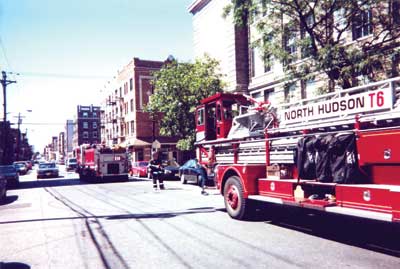 |
| (2) Using a guide to back a rig into position assists in safety and control. Here it is done in the soft investigative mode. Remember, just because there is a fire does not mean that you abandon this position. Every time you correctly conduct this operation, the more likely you will do it when there is something showing. (Photo by author.) |
It must also be mentioned that the areas between the hard and soft environment vary depending on the situation. For instance, as mentioned above, a very common semi-hard environment, for lack of a better term, is when you arrive at a “nothing-showing” situation. If you are not conducting disciplined and efficient operations as assigned when nothing is showing, how are you ever going to be disciplined enough to conduct them properly at a working fire on arrival or when a fire is found during the investigation? I have witnessed this firsthand, and it has caused major problems on the fireground that can be difficult to overcome as the incident progresses. The remainder of this discussion will cover those areas that, if not addressed in the semi-hard environment of the investigative mode, will have detrimental and unintended consequences in the hard environment of the emergency ground.
APPARATUS POSITIONING
You only get one chance to position properly, especially in the fire area. If positioning is improper when nothing is showing, it will not change when there is a real incident. Address it as soon as possible after the “nothing-showing” incident is mitigated while the companies and the apparatus are still in place at the scene. It is difficult to ignore or argue regarding a large piece of apparatus that is out of position. It may be a communications issue, it may be a perception issue, or it may be the fault of a policy; you now have an opportunity to adjust it. Use it as a training opportunity, but ensure the officers understand your expectation regarding the proper positioning, and be consistent in your vigilance. As an officer, when you don’t correct a situation that makes you uncomfortable the first time it happens, you can guarantee that there is a potential for the same situation to be more out of whack the next time (and more people will be operating that way because if you ignored it the first time, it must be okay).
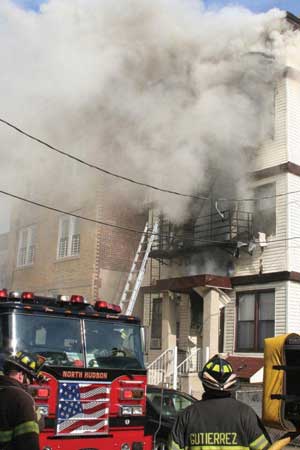 |
| (3) Scene assignments dictate critical activities that must be performed on the fireground. Roof ventilation must be a priority at every fire in flat-roofed buildings. Here, the building is choking on itself because the first-arriving ladder did not open the roof. If you as an officer think any position is more important in this type of building, you will probably have a tough time making this building behave. (Photo by Ron Jeffers.) |
INITIAL SCENE SOPs
When the playbook is disregarded in the soft environment of the investigation mode, the team will be out of sync when the time comes for a coordinated effort where all players depend on each other for success. If your people are wandering all over the fireground during the investigation and you are not getting the proper reports, take action to address it the first time, every time. Some people should be wandering as per standard operating procedures (SOPs), conducting reconnaissance of all areas of the building and perimeter, while others should be standing by at the ready to support the findings of the investigation and to follow your orders based on those findings. Suppose your SOPs require that when nothing is showing engine company firefighters are to be standing by, properly equipped and ready to pull hose at the back of the attack engine while their officer and the ladder company investigate? They must be there all the time every time. Sometimes when complacency is allowed to creep in, they wander into the building or drift away and tend to socialize and then, when the line is needed, there is no one standing there ready to pull. This causes a delay in getting water on the fire. Once the incident stabilizes and the nothing showing turns out to be, in fact, nothing, the companies can have their little conversations, but while you are actively investigating and looking to stabilize a situation, they are expected to be where the SOPs dictate. It is all business.
Adhere to the equipment assignment given in the initial scene assignments. A firefighter without the proper equipment is useless and creates delays that compromise safety. For ladder company personnel, assign thermal imaging cameras (TICs) and forcible entry tools (especially when confronting a commercial or other difficult-to-force occupancy that requires specialized equipment), and enforce their use through SOPs and proper supervision. I am almost ashamed to say this, but I have seen and have read of many instances where firefighters have left portable radios on the apparatus, leaving a company inside the building or on the roof unable to contact command. This has led to line-of-duty deaths (LODDs) in the past. When you really look at it, it is a good bet that they had been leaving the radios on the apparatus on prior responses before this incident where the casualty occurred, but it was likely never addressed and thus became habit.
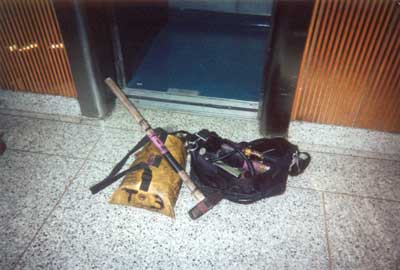 |
| (4) Failure to take the proper equipment into the building when nothing is showing will lead to the same failure when there is a fire. High-rise buildings and large-area structures require a deviation from the “routine” irons assignment. Here we see a rope bag, a rabbit tool, and a maul, all essential for high-rise ladder company operations. (Photo by author.) |
Speaking of challenging buildings, how many times do you have to read about firefighters lost or killed inside large-area structures because they failed to bring a lifeline in with them? This should be standard equipment whenever on a response to a large-area building, reinforced by an SOP and enforced 100 percent of the time. If it is not and companies are not used to carrying a lifeline on arrival at a large-area building when nothing is showing, there is no way they will take it with them when there is fire showing. It just won’t happen unless it is enforced at all incidents all the time.
Enforcing scene assignment SOPs is the responsibility of the on-scene company and chief officers and is required to get the initial operation in motion. I have often said that if you don’t have an initial scene assignment SOP, then every fire will be different, depending on who is running the operation and who or who is not listening/cooperating. Dedication to scene assignments is both a company and a chief officer responsibility. Training and the setting of expectations before the alarm comes in are required. SOPs are departmental expectations and, as such, must be part of the expectations set by every officer. Initial scene assignments put the right people in the right place and allow command to not only ensure standard coverage of the most critical areas of the fireground, but they also allow him to think ahead to where he will assign additional responders once they arrive. The incident commander (IC) will base this on not only what he observes but, more importantly, also on what he is told through the reports from the areas he can’t see. Scene assignments put personnel in these places for the distinct reason of supplying this information to command. Failure to enforce coverage of unseen areas (and all areas covered by the initial scene assignment SOP) will lead to a tactical breakdown somewhere, somehow. The issues created by buildings that are misbehaving in these unseen areas are often difficult to overcome. To best ensure this coverage will be provided in a consistent manner, ensure expectations are set before the fire, and never fail to follow through on them in the soft environment.
PPE REQUIREMENTS
As stated above, if as an officer you can’t get this right, you should not be an officer (or on the job), and I will have a hard time trusting you to properly supervise your subordinates and carry out your orders. Your enforced policy should be that everyone should be properly geared up on the fireground, all the time. If they are not, they will have some explaining to do. This is true for chief officers as well. National Fire Protection Association standards direct that everyone on the fireground should be in full personal protective equipment (PPE), not just those below the rank of chief-everyone! Geared up means PPE on and properly worn (including chin straps, waist straps, hoods, and proper gloves) and that self-contained breathing apparatus (SCBA) is donned and ready. In North Hudson (NJ) Regional Fire and Rescue, we have a PPE guideline policy that is very clear and well enforced. Being out of gear is the exception, not the rule. That is a direct responsibility of the officers. If you can’t be trusted to get this most basic of safety issues right, what else should you not be trusted with?
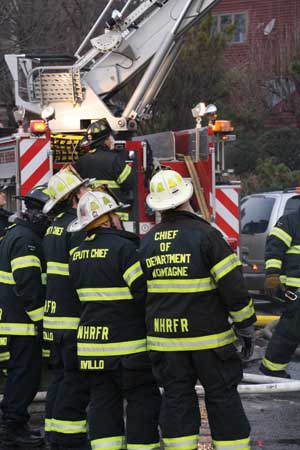 |
| (5) As an officer and especially if you are a chief, it is your job to set a proper example all the time. Start by wearing your gear. (Photo by Ron Jeffers.) |
ACCOUNTABILITY ISSUES
The best accountability system is the one in which there is a solid command structure supported by solid SOPs and well-trained and disciplined officers and firefighters operating as per those SOPs. If this is not in place, all the accountability gadgets and doodads you have are doomed to fail. As a fire officer, never let a piece of plastic or some type of computerized technology do your job of accounting for your personnel.
I am a big fan of decentralizing the fireground-that is, putting in a division supervisor wherever I have an area or concern that I cannot directly control (or see). I then feed companies into those areas and keep track of progress through reports. I really like the use of the personnel accountability report (PAR) to keep the command board updated. When I do this, rather than doing a complete roll call, I contact each division commander and request a PAR of his assigned companies. It is then up to the company officers assigned to those divisions to account for their personnel and report the results verbally to the division supervisor. At a recent six-alarm fire, I conducted at least a dozen PARs with the division commanders. My command technician (com tech) is also assigned accountability. At the incident evaluation after a fire, he noted how much this helped make his job easier and keep companies tracked.
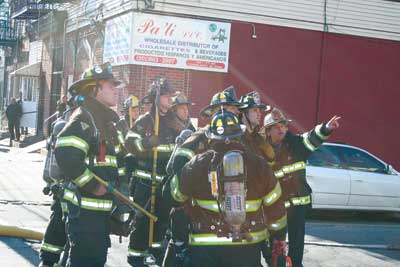 |
| (6) All assignments begin and end at the command post. Enforcing this policy assists greatly in maintaining accountability. (Photo by Ron Jeffers.) |
In addition, insisting and enforcing consistently that all assignments begin and end at the command post are additional ways to keep track of the location of companies. Once they are released from a division (which is first transmitted by radio from the division supervisor to the command post), companies are to report directly to the command post for reassignment, rehab, or release. Along with the PARs, this allows the com tech to update the command board and keep it current.
In fact, once I have a tactical reserve at the command post, I usually contact the division commander and offer relief. His job is to tell me whom he is relieving and whom he needs. I will then confirm who is coming out for relief and who is going in to work. Those companies going in are instructed to report to the division commander for assignment in his division. When everybody buys into it and abides by it, it is a very efficient system.
COMMUNICATIONS
Proper and disciplined communications tie right into accountability. As an IC, I base a great deal of my decision making on reports. I can only really see about 20 percent of the fireground, the A side. That leaves the interior, the roof, the sides of the building, and any exposures to be seen, assessed, and reported on by those people who are directed as per SOP or through orders based on the situation. As an IC, the only way I can help any of those people successfully execute their assignments is by supporting them with people and equipment. Further, as the IC, I am the only one who can support their position, and I can only get resources to them if they tell me about their situation and what they need. Poor reporting on the fireground or, worse, no reporting, comes about as a result of a failure to enforce communication guidelines and discipline in the soft environment: on the training ground and in the “nothing-showing” mode of operation. In addition, as the guardian of the command post, I make it a point to be uninformed (stupid) and nosy. If I am the former, I will seek reports so I can get smarter about what is happening on my fireground. Regarding the latter, being nosy correlates to the fact that if I don’t get what I am looking for in the reports, I will keep asking until I get it.
You must set expectations regarding the information required in reports from around the fireground, from the arrival report to the ongoing reports from companies and division commanders assigned to the critical areas. It must be enforced in the soft environment so that it is effective in the hard environment. If you are not getting good information when nothing is showing, don’t count on it when you have to go to work. In addition, teach your people to prioritize radio transmissions, control their emotions (which lead to adrenaline-driven activities) and voices, and recognize when there is too much chatter on the radio.
ALL-SIDES COVERAGE AND REPORTING
If you are an IC, whatever you can’t see from the command post is a question that needs an answer. If you are in one of those areas not visible from the command post, everything you see and will need in regard to personnel and equipment (most of which you should already have) will come from the command post. This again ties into the requirement for accountability. All-sides coverage and reporting are not options on the fireground.They are critical situational requirements and must be communicated at every incident.
Two issues arise here. The first is a lack of an SOP regarding coverage and reporting. Since no one is assigned by SOP, it is usually forgotten or is an afterthought. That is unacceptable. This is usually followed by no one being assigned other critical issues like ventilation or stretching a second hoseline. If your department has no policy on coverage assignments, it is a good idea to address it immediately. Find someone who has one, steal it, and tailor it to your departmental needs.
The second issue is the unenforced SOP. This is even worse. Failure of a policy is a failure of discipline and supervision. It is equally unacceptable if not more so. Again, go back to the “nothing-showing” scenario. If your companies are not routinely going to those assigned areas to assess conditions and make a report, don’t ever think they will do it at a real incident. If you are an officer reading this and it is not happening under your command, it is your fault. Review the policy, set the expectations, and consistently follow through on them.
If you allow a breakdown in operations when nothing is showing (an indication of your failure to care-the most “real” attribute you bring to your command), forget about operational discipline when fire is blowing out windows and threatening to spread to exposures. Thus, little things done right in investigation mode pay BIG dividends when something is showing.
● ANTHONY AVILLO, a 28-year veteran of the fire service, is a deputy chief in North Hudson (NJ) Regional Fire & Rescue, assigned as 1st Platoon regional tour commander. He has a bachelor’s degree in fire science from New Jersey City University. An instructor at the Bergen County (NJ) and Monmouth County (NJ) Fire Academies, Avillo is also an FDIC instructor and a member of the FDIC advisory board and the editorial advisory board of Fire Engineering. He is the author of several books published by Fire Engineering, including Fireground Strategies, 2nd edition and Fireground Strategies Workbook Volumes I & II, and is a collaborator in the Tactical Perspectives DVD series. He received the 2012 Fire Engineering/ISFSI George D. Post Instructor of the Year Award.
Anthony Avillo will present “Fireground Officer Development: Preparing for the Hard Environment” on Monday, April 22, 2013, 1:30 p.m.-5:30 p.m., and “Command Expectations: Fitting the Action Plan” on Wednesday, April 24, 10:30 a.m.-12:15 p.m., at FDIC 2013 in Indianapolis.
Fire Engineering Archives

